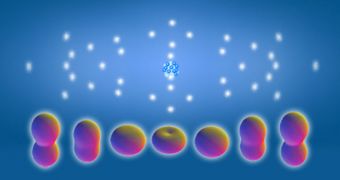An international team of experts has for the first time managed to observe the motions of an atoms' outer electron in real time. The accomplishment was made possible by using ultrashort pulses of laser light at the attosecond (one quintillionth of a second) scale. The work was conducted by scientists at the Max Planck Institute of Quantum Optics (MPQ) in Garching, Germany, the US Department of Energy’s (DOE) Lawrence Berkeley National Laboratory (Berkeley Lab), and the University of California in Berkeley.
“With a simple system of krypton atoms, we demonstrated, for the first time, that we can measure transient absorption dynamics with attosecond pulses. This revealed details of a type of electronic motion – coherent superposition – that can control properties in many systems,” explains UCB professor of chemistry and physics Stephen Leone. He also holds an appoint in the Chemical Sciences Division at the Berkeley Lab. The main analysis tool the investigators used is called attosecond absorption spectroscopy (AAS), and it allowed researchers to time the oscillations between simultaneously-produced quantum states of valence electrons.
The group explains that it's these oscillations that drive the motions of electrons. “The method developed by our team for exploring coherent dynamics has never before been available to researchers. It’s truly general and can be applied to attosecond electronic dynamics problems in the physics and chemistry of liquids, solids, biological systems, everything,” explains Leone. The first step of the new investigative process was to ionize krypton atoms, by simply taking out one or more outer valence electrons. This was done with pulses of near-infrared laser light at the femtosecond scale.
Then, by using considerably shorter laser pulses (about 100 attoseconds), the group managed to measure the effects that removing those valences had on the orbitals of outer electrons. Details of the new conclusions appear in a paper entitle “Real-time observation of valence electron motion,” which is published in the August 5 issue of the esteemed scientific journal Nature. This work was supported by the Max Planck Society, King Saud University, and the Munich Center for Advanced Photonics, in Germany.

 14 DAY TRIAL //
14 DAY TRIAL //